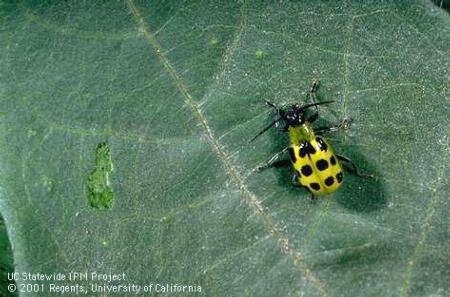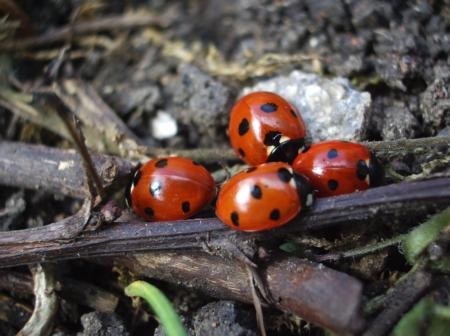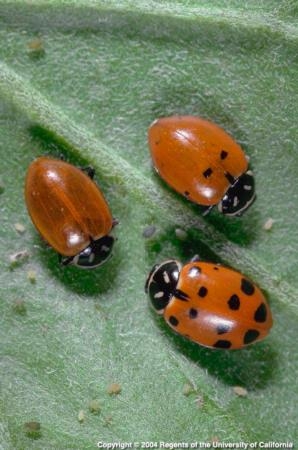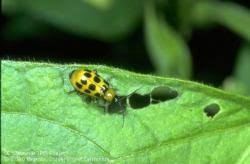By Denise Seghesio Levine, UC Master Gardener of Napa County
Most of us have warm, fuzzy feelings about ladybugs. We feel special when a ladybug lands on our hand. We charm our children with early garden experiences and recite iconic nursery rhymes as we entreat the cheerful red beetles to “fly away home.”
Ladybugs, or lady beetles, with their shiny red shells and black dots are friends in the garden, helping to eradicate aphids and other unwanted pests.
But what about the yellow-green version? You may have noticed chartreuse, shiny-shelled “ladybugs” with 11 or 12 shiny black spots as well. The yellow versions do have longer antennae than the red versions, but so what? Are they yellow ladybugs?
These yellow-green beetles are actually cucumber beetles, Diabrotica undecimpunctata. Unlike friendly ladybugs, cucumber beetles can wreak havoc in your garden and are hard to get rid of.
Adults cause the most damage.
If you are finding large holes in the foliage of your beans, cucumber, melons, squash, corn, potatoes, tomatoes, eggplant, beans, peas, beets, asparagus, cabbage, lettuce and other vegetables, look for these little pests on top of and under leaves.
Just about all the stone fruits are also susceptible to cucumber beetles, including peaches, apricots and plums. Shoots and blossoms of peas and beans, cucumbers and melons are not safe from attack either. I do not think they eat onions.
And this really points to the problem with trying to get rid of this voracious pest. Rotating crops (not planting the same crop in the same space for a few rotations) is one of the few effective ways to control Diabrotica undecimpunctata, but how do you rotate crops effectively when cucumber beetles eat almost everything?
Cucumber beetles are about ¼ inch long with a black head. Their larvae are whitish and slender although the head and tip are slightly darker. They sport three pairs of short legs and feed exclusively on roots as they develop. They like roots of corn, beans, wild grasses, small grains and sweet peas. They can overwinter in beds where they ate your crops the previous year or move out to the weedy outskirts.
Normally at this stage Diabrotica undecimpunctata do little damage, and most plants can survive. It is when the larvae mature and your plants begin to grow and leaf out, or your next batch of seeds start to germinate and push up, that the real onslaught begins.
Newly emerged seedlings are most susceptible and can be destroyed in a few days. Once plants get large enough, they might look terrible with munched leaves and damaged fruit, but they will usually survive.
It happens like this. Beetles overwinter in your garden and surroundings. When your spring plantings begin to emerge, adults begin laying their yellow-orange eggs at the roots. Tucked in cracks in the soil and at the base of plants, eggs are invisible to all but the most diligent examiner.
When the larvae hatch, they spend their first two to six weeks eating the roots of your plants. They emerge as adults about the same time your vegetables begin leafing out. Then they begin feeding on foliage, seedlings and small plants. They can reproduce and go through this cycle up to three times each year.
So what can you do if you find these culprits in your garden? If you do have room to rotate your crops, do it. And clean the weedy outskirts of your garden so they do not have places to overwinter.
There really are no recommended insecticides. They would need to be applied too often to be effective. Botanical controls, while safer, tend to be especially short-lived in efficacy.
A better strategy is to use protective cloths or screens over your newly sown seed or just-planted transplants, removing the protection only when the plants are large enough to sustain damage or begin to flower. Removing barrier cloth at flowering is essential to allow beneficial insects to pollinate.
There is some ongoing research on the effectiveness of natural predators, but not much conclusion on the efficacy. Since cucumber beetles are attracted to cucurbitacins, some experiments have used lures containing cucurbitacin powder. The method has been effective, but there are no current plans to move ahead with such a product commercially. My own preferred technique is more rudimentary. Remember, these insects are not your friends. When I see yellow “ladybugs” on my plants, I squish them.
Next workshop: “Home Vineyard: Part 2” on Saturday, September 14, from 9:30 to 2:00 p.m., in Calistoga. Learn techniques to maintain your new or existing home vineyard. Workshop location will be provided after registration. For more details & online Registration go to http://napamg.ucanr.edu or call 707-253-4221
The UC Master Gardeners are volunteers who provide UC research-based information on home gardening and answer your questions. To find out more about upcoming programs or to ask a garden question, visit the Master Gardener website (http://napamg.ucanr.edu) or call (707) 253-4221 between 9 a.m. and noon on Mondays, Wednesdays or Fridays.
Attached Images:



